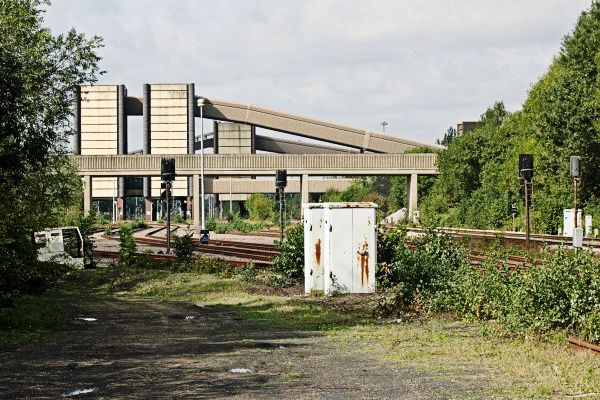
Gascoigne Wood Mine – hoppers used for the loading of trains with coal
Copyright © John Rinder and licensed for reuse under this Creative Commons Licence
One outcome of the sharp rise in oil prices forced by OPEC in 1973 and the following Stock Market crash was a change in government policy towards exploiting indigenous sources of fuel. Fortunately for the NCB its Regional geologist, Ron Goossens, completed a series of boreholes in 1972 which proved a large area of workable Barnsley seam, and other seams, under the rural area between Selby and York.
A proposal for a super-pit emerged which involved driving two surface drifts, sloping at 1 in 4 for around 800 metres and then gradually becoming horizontal. Spine tunnels were then driven from the bottom of the drifts in a ‘preferred horizon’, a sandstone / siltstone sequence, about 80m below the Barnsley seam, using a Robbins full face tunneling machine, to link the five satellite mines at: Wistow, Riccall, Whitemoor, Stillingfleet and North Selby. Those five sites were to have a small footprint, with inobtrusive buildings in York stone and red brick to match local materials. Their roofs were low pitched to reduce height further. The headgear on each shaft was to be low profile and fully enclosed in masonry. Sites were also screened by bunds made of sinking spoil and landscaped. In order to avoid the costs of problems caused by subsidence, the route of the East Coast Railway was re-aligned westwards from the point where the line crossed the river Aire at Temple Hirst to Colton Junction on the former NER’s York to Normanton line. This involved building 22.3 Km of entirely new track. The original route across the coalfield was abandoned.
The site chosen for the two drifts was at Gascoigne Wood sidings, alongside the Leeds to Hull railway. They were driven, using a combination of grouting and freezing to get through the Permian Magnesian Limestones and Basal Sands, between 1978 and 1981. The output from the five mines was fed into vertical staple bunkers, which were used to regulate a constant flow of coal onto the trunk conveyor. This belt brought coal up the drifts to the treatment plant before it was loaded onto trains and taken to local power stations. Spoil from the washing plant was tipped nearby and was the only significant tipping permitted.
Unfortunately, despite its high outputs – in December 1987 Wistow set a UK and European output record of 68,362 tonnes in a week – but there were serious geological problems to contend with. The peripheral areas to the coalfield were relatively unexplored. The Barnsley seam was known to split to the east and south, and seismic exploration showed that faulting increased south of Whitemoor. The remainder of the Selby coalfield was structurally similar to that experienced elsewhere, like Kellingley Colliery for example. Towards the incrop of the Barnsley seam with the overlying Permian, there were also inflows of water. There were also serious floor lift problems to contend with, primarily associated with the proximity of the underlying Dunsil seam.
When British Coal was privatised in 1994 the Selby complex was acquired by RJB Mining (UK) Ltd. It was restructured as RJB Mining PLC by 1999 and by 2001 had become UK Coal Mining Ltd. There had probably been an assumption that further pits would be sunk, but the early closure of North Selby and Whitemoor, in 1997 and 1998 respectively, and the falling price of coal began to make the project unviable. After losing around £30m a year for three years, in July 2002, UK Coal announced the phased closure of the complex. The workforce was reduced by men retiring, retraining or transferring them to other collieries. The remaining three mines closed in 2004 after a working life of 21 years.
From its inception, the Selby Coalfield was planned to produce 10 million tons per annum, over a period of 25 years. Reserves were about a quarter of a million tons. Unfortunately, although other coal reserves existed, working was initially restricted to the Barnsley seam, as the extraction of too much coal would have caused excessive subsidence to the Vale of York, and increased the risk of flooding.
Return to previous page
